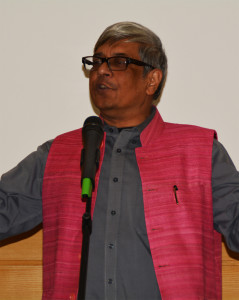UNESCO

Dr Bibek Debroy at Unesco conference on Sanskrit
The Permanent Delegation of India to UNESCO has organised on Thursday a special conference with a focus on “Sanskrit, A classical Language- Beyond Heritage” with Indologist, economist and member of the prestigious NITI (National Institution for Transforming India) Aayog, Dr. Bibek Debroy, as a guest of honour. A way to show, on the occasion of the International Mother Language Day, that Sanskrit is a living language, in India but also in the rest of the world, through linguistic and cultural connections.
The programme at UNESCO in Paris had two main parts. A morning conference featured a discussion with panelists Dr. Debroy and Dr. Daniel Negers of the National Institute for Oriental Languages and Civilizations, in Paris. It developed the nuances and the rich diversity of Sanskrit before an international audience of diplomats, UNESCO staff, Indologists, academics, French personalities, Indians living in Paris and journalists.
The discussion was moderated by Christopher Moseley, expert linguist, former journalist with the BBC and also the Editor in Chief of the UNESCO Atlas of the Worlds’ Languages in Danger. He emphasised the need to preserve Sanskrit as a world gem.
Sanskrit, which means “pure”, “refined”, is one of the oldest Indo-European languages and dates back as early as the second millennium before Christ, in its Vedic form. It is the first sacred language of Hinduism and a language used in many other religions: Buddhism, Sikhism or Jainism. You can trace it back in many sacred, poetic, scientific or literary texts, such as the famous epic Mahabharata.
Sanskrit is one of the 22 official languages in India and is still used as a ceremonial language in Hinduism. Buddhists do also sing Sanskrit hymns. It is not a dead language but still spoken as a conversational language by dozens of thousands of people in India.
Dr. Daniel Negers, a specialist of Telugu, underlined the influence of Sanskrit on this South India language, notably in popular poetic chants.
Bibek Debroy told Media India Group why Sanskrit is so important: “It has a very old tradition and represents a treasure house of knowledge. It is part of a legacy, part of a history and a culture. It has an amazing large corpus of texts that are related to religions, not only Hinduism but for instance Buddhism, and also of texts that are related to literature. It is a language that used to be a medium of communication amongst people in India for years and years and that is still very much a living language. My guess is that at least 100.000 people still speak or understand Sanskrit in one form or the other. Please do also remember that many of the practices that are centred around religion, the Mantras, the hymns, the rituals, are all in Sanskrit. So there are several people who actually understand Sanskrit even if they don’t converse in that language on a day to day basis.”
Poetic recital
This issue now is to preserve this language and to teach it well, added Bibek Debroy. “In the last 50 years, we have lost some familiarity with Sanskrit. There are two reasons why Sanskrit is not taught and learned much more. One is the quality of teaching. The text books and the teachers are not that good. You need to learn it also by conversing, not only through memorizing grammar, which is way it is taught. The second reason is that Sanskrit has also to be taught in Sanskrit. Today, it is taught in other languages.”
It is a must to consider Sanskrit as a living language but also as a cultural vehicle that has influenced many other cultures around Asia and around the world, and vice versa. “Sanskrit has influenced the evolution of languages not only in India but elsewhere in South Asia and South East Asia. For example, the national motto in Nepal is in Sanskrit. The other way around, words from other languages, whether it is Persian, Arabic or Greek, have faded into the Sanskrit vocabulary and thereby have enriched it, which is the way any living language should be”, explained Bibek Debroy.
To show this global influence of Sanskrit, regardless of its commercial use, another event was hosted jointly, in the evening, by the Indian Mission to UNESCO along with the Missions of Bangladesh, China, Greece, Iran, Indonesia, Lithuania, Malaysia, Nigeria, Saudi Arabia and Turkey. It was “Celebrating Linguistic and Cultural Diversity”, with a rich panorama of cultural and artistic presentations from those countries and the presence of personalities who came specially on this occasion, such as the Minister of Cultural Affairs of Bangladesh, Asaduzzaman Noor.
Dr. Debroy offered a poetry recital in Sanskrit, a first in UNESCO but probably not the last occasion to celebrate a language that touched the audience with its melodious and profound resonance.









